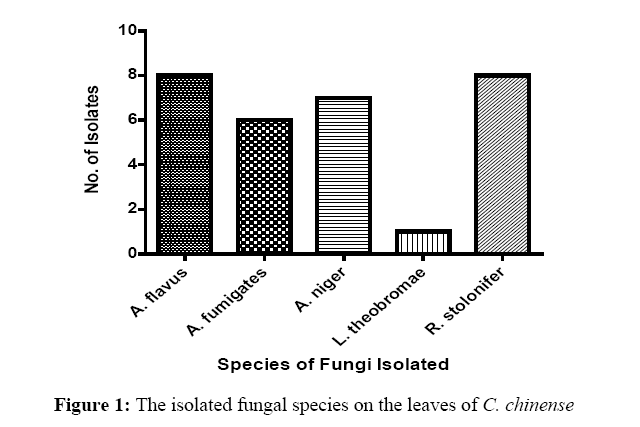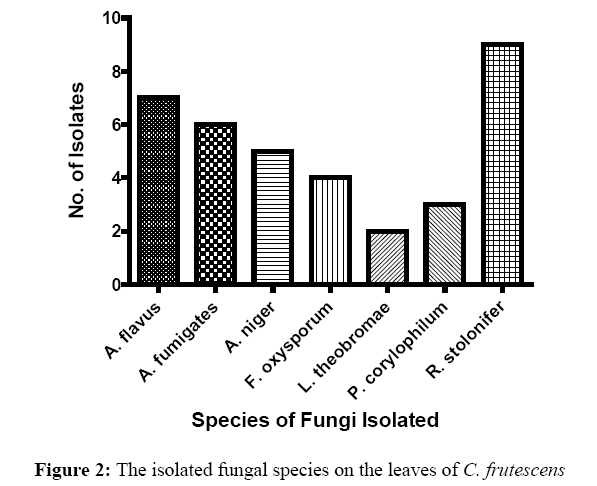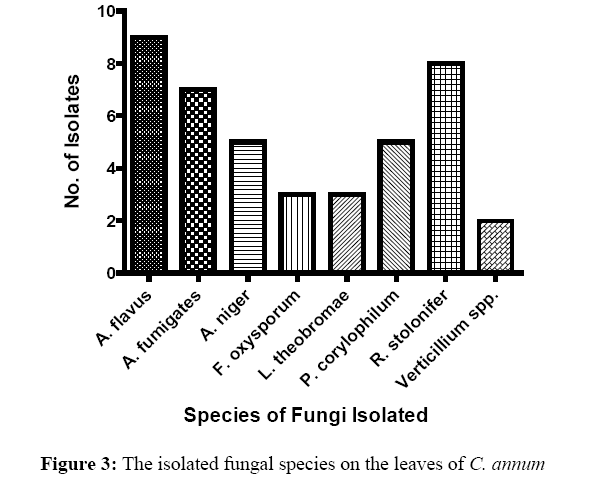ISSN : 2348-1927
Annals of Biological Sciences
Evaluation of Fungal Species Isolated from Three Different Varieties of Pepper (Capsicum chinense, C. frutescens and C. annum L.) in Dutsin-ma, Katsina State
AA Lema1*, A Mudansiru2, BA Alexander3, MJ Sakinatu3
1Department of Biological Sciences, Al-Qalam University, Katsina, Nigeria
2Department of Biological Sciences, Usmanu Danfodiyo University, Sokoto, Nigeria
3Department of Biology, Federal University Dutsin-ma, Katsina State, Nigeria
Abstract
The study was carried out to determine the fungal species affecting the leaves of different pepper varieties in Dutsinma Town, Katsina State. The three pepper varieties studies were Capsicum chinense, C. frutescens L. and C. annum L. A total of twenty seventy (27) samples were collected, 9 each of the three different pepper variety from three fungi devastated farms in the study area. Samples of leaves from the collected pepper varieties were separately chopped up into smaller bits using flame-sterilized scalpel and following standard procedures, they were transferred into prepared PDA plates to which streptomycin (0.2% final concentration) has been added to suppress bacterial growth. The fungal colonies that emerged were continuously sub-cultured in order to obtain a pure culture of the fungal isolates. Isolated fungi were identified based on colony and morphological characteristics such as colour, shape and type of spores observed with the microscope. The fungal species isolated were Aspergillus flavus, Aspergillus fumigates, Aspergillus niger, Fusarium oxysporum, Lasiodiplodia theobromae, Penicillium corylophilum, Rhizopus stolonifer and Verticillium spp. some of these species were reported to have caused various diseases in pepper and other plants species which include soft rotting, damping-off, wilting and general spoilage. Efforts were recommended to alert growers in this area, and similar places on the need to safeguard their pepper plants against fungal infections.
Keywords
Fungi, Capsicum, Infection, PDA, Aspergillus
Introduction
Capsicum is a unique genus of the family Solanaceae. More than 30 species have been described in the genus, but only five of them, Capsicum annuum, C. chinense, C. frutescens, C. baccatum var. pendulum and C. pubescens are domesticated [1]. In Nigeria, pepper is mainly grown around the Savanna ecological zones as a crop mixture or mono crop both during the rainy season and dry season under irrigation. It is used in fresh form or as paste, pure and juice or ground with other vegetables in the preparation of stew and soup [2]. Pepper has important roles in various aspects of economy, food and pharmaceutics. It has the highest content of vitamin C among all plants and has important medicinal properties such as prevention of heart disease, actuation of blood ambulation and antioxidant characteristics [3].
Despite the importance of pepper as spice, peppers are subject to a number of diseases that reduce both field and market value of the fruit. Pests and diseases are some of the important factors militating against optimum production due to massive loss of pepper produce both on the field and in storage. These diseases include those that are soil borne and affect the roots and stems and others that affect the leaves and the fruits. The enormity of these diseases, which may he caused by bacteria fungi and viruses vary from country to country depending on the climatic conditions and the virulence of the causal agents [4].
The major fungal pathogens affecting pepper species include Phytophthora capsic L. a soil-borne fungus that invades the base of the stem and causes a sudden and complete wilting of the aerial parts, especially when pepper is planted in furrow irrigation [5]. Verticilliun dahliae and Sceletium rolfsii they are soil borne fungi, that have been reported to cause serious wilting in pepper especially of the perennial species and they are host-specific, their early invasion of pepper, especially the young seedlings has been found to cause complete loss of the seedlings [6]. In the majority of Mediterranean, sub-tropical and tropical conditions, pepper species are attacked by a number of poly viruses.
Disease control is one of the most important factors in the production of pepper crops. The quality and performance of Pepper can be affected by invading microorganisms including fungi that can prevent optimum yield [6]. Research on identification of fungi associated with the plant is seldom. In view of the economic importance of pepper and the fact that diseases and pests continue to militate against optimal production, this study was carried out to evaluate the pathogenic fungi affecting the leaves of pepper plant.
Materials and Methods
Collection of sample
A total of twenty seventy (27) samples were collected, 9 each of the three different pepper varieties (C. chinense, C. frutescens and C. annum) from three fungi devastated farms in Dutsin-ma Town. Whole plant was collected in to a sterile polythene bag. Each specimen as collected was tagged with a voucher label. Parts to be examined in the identification process were kept separately [7]. Identification of such plants was achieved by the aid of herbarium specimens at Bayero University Kano Herbarium [8].
Leaves preparation
Samples of leaves from the collected pepper varieties were separately chopped up into smaller bits using flamesterilized scalpel. They were surface-sterilized with 70% ethanol for 3 min and then rinsed with sterile distilled water. They were blotted dry in between Whatman No. 1 filter papers.
Fungal analysis
The media used for the research was prepared using its manufacturer’s instructions. Petri dishes used for culturing were sterilized at 121°C in an autoclave. The blotted bits of leaves were then aseptically transferred into prepared PDA plates to which streptomycin (0.2% final concentration) has been added to suppress bacterial growth [9]. This was repeated in triplicate in both cases and incubated at 28 ± 3°C for 3 days. The fungal colonies that emerged were continuously sub-cultured in order to obtain a pure culture of the fungal isolates.
Isolation of fungi
Isolated fungi were identified based on colony and morphological characteristics such as colour, shape and type of spores observed with the microscope [10]. The Morphological characteristics and appearance of the fungal isolated were confirmed and authenticated with the help of Mycological Atlas of Robert and Ellen (1988) .
Results
Identification of the collected pepper varieties
The identified pepper varieties were recorded as below (Table 1):
| S. No. | Samples | Botanical Name | Voucher Number |
|---|---|---|---|
| 1 | Sample I | C. Chinense | SSK001 |
| 2 | Sample II | C. frutescens | SSK002 |
| 3 | Sample III | C. annum | SSK003 |
Table 1: The identified pepper varieties
Discussion
The study conducted showed that the fungal species Aspergillus flavus, Aspergillus fumigates, Aspergillus niger, Fusarium oxysporum, Lasiodiplodia theobromae, Penicillium corylophilum, Rhizopus stolonifer and Verticillium spp. were found on the affected leaves collected (Table 2). The fungi isolated are a reflection of the possible diseases that could affect pepper leaves and the plant in general. Out of the fungal species isolated R. stolonifer was found to have highest rate of occurrence in all the three pepper varieties studied. This is similar to what was reported by Tafinta et al. [10] in their study of fungi associated with the spoilage of sweet orange (Citrus sinensis).
| Type of Fungal Isolates | C. chinense | C. frutescens | C. annum |
|---|---|---|---|
| Aspergillus flavus | ? | ? | ? |
| Aspergillus fumigates | ? | ? | ? |
| Aspergillus niger | ? | ? | ? |
| Fusarium oxysporum | ? | ? | |
| Lasiodiplodia theobromae | ? | ? | ? |
| Penicillium corylophilum | ? | ? | |
| Rhizopus stolonifer | ? | ? | ? |
| Verticillium spp. | ? |
Table 2: Fungal species isolated on the leaves of different varieties of pepper
In a study by Balogun et al. [9], Penicillium spp., Aspergillus flavus and Aspergillus niger were isolated from pepper fruits, leaves and seeds and were demonstrably pathogenic on pepper plant. This study is in agreement with Balogun’s in the isolation of Aspergillus flavus, Aspergillus fumigates, Aspergillus niger and Penicillium corylophilum as part of the pathogens of pepper leaves. The Penicillium corylophilum isolated from C. frutescens and C. annum indicates the vulnerability of the plants to diseases as Parker [11] reported that plants are vulnerable to infection by Penecillium spp. during germination and juvenile stages resulting in pre-emergence damping off (Figures 1-3).
Anjorin and Mohammed [12] reported a strong relationship between different fungal species density, growth and yield of host plant. Isolation of different fungal species on all the pepper varieties studied showed vulnerability of the plant to fungal infection. Although the rate of occurrence of some fungi such as Fusarium oxysporum and Lasiodiplodia theobromae was low, studies have shown that a small percentage of infection on the plant and most especially on seed and leaves is enough to cause epidemics [13,14].
The three Aspergillus species isolated were found to be consistently present on the leaves of all the three pepper varieties. This was similar to what was reported by Balogun et al. [9] in his identification of fungal species affecting young seedlings of pepper in University of Ilorin, Nigeria. Aspergillus spp. is reported to produce certain mycotoxins which are immunological in nature. In addition, this fungus is also causative agent for many rot diseases in plants. These features of Aspergillus enable them to cause decay of various organic substances including leaves, fruits, vegetables, nuts, beans, cereals, herbs and wood [15]. The leaves of the pepper species collected were observed to be wilting, this is a common symptom of a disease called black mold causes by Aspergillus, black mold is a very serious disease that affect plants in general and vegetables in particular [16]. This disease is a limiting factor for vegetable production effecting both their quality and quantity [17].
Some of the pepper species isolated such as Rhizopus stolonifer was confirmed to cause spoilage on some plants such as orange [13]. Rhizopus is well-known to cause soft rotting in fresh fruits, vegetables, flowers, bulbs, tubers and seedlings [4]. And it has been reported to be isolated in pepper species [9].
Conclusion
About seven fugal isolates were found on the affected pepper species. It could therefore be reasonably inferred that it was the major cause of the sudden drying and defoliation of the pepper plants on the field from which the samples were collected. The level of disease observed on the naturally infected field peppers warrants concerted efforts to alert growers in this area, and similar places on the need to safeguard their pepper plants against fungal infections. This is in order to reduce losses, which could result from damages incidence both on the field and in storage under favourable environmental condition.
References
- Pozzobon, M.T., Schifino-Wittmann, M.T. and Bianchetti, L.D.B., Bot J Linnean Soc, 2005. 151(2): p. 259-269.
- Jaliya, M.M. and Sani, B.M., Agric Eng Series 7, 2002. p. 1-10.
- Salehi Surmaghi, M.H., Med Plants Phytother, 2006.
- Agrios, G.N., Plant Pathol, 2005.
- Arnan, M., Pinthus, M.J. and Kenneth, R.G., Can J Plant Sci, 1998. 50: p. 283-288.
- Lamido, A., Department of Agronomy ABU, Zaria, Thesis Unpublished, 1994.
- Leonie, H. and Bronwen, C., Geographic Analysis and Research Unit. South Australia, 1997. p. 13-14.
- Ehigiamusoe, R., Roland Ehigiamusoe Ent., Ibadan, Nigeria, 2013. p. 8-16.
- Balogun, O.M., Oijkyhmi, O.A. and Fawou, O.B., Agric Res Dev, 2005. 4 (5): p. 160-168.
- Tafinta, I.Y., et al., Nig J Basic Appl Sci, 2013. 21(3): p. 193-196
- Parker, K.C., North Carolina State University, 1999.
- Anjorin, S.T. and Mohammed, M., J Agric Soc Sci, 2009. 5: p. 77-80.
- Ekhuemelo, C. and Ebenezer, J.E., Agric Biol J N Am, 2013. 4(4): p. 370-374.
- Baker, S., Med Mycol, 2006. 44: p. 17-21.
- Sharma, A., J Zhejiang Univ Sci B, 1991. 6(8): p. 736-742.
- Truckesses, M.W. and Scott, P.M., Food Addition Contamination,2008. 25: p. 181-192.
- Barnett, H.L. and Hunter, B.B., Burgess Publishing Co. 1980. p. 273.
Open Access Journals
- Aquaculture & Veterinary Science
- Chemistry & Chemical Sciences
- Clinical Sciences
- Engineering
- General Science
- Genetics & Molecular Biology
- Health Care & Nursing
- Immunology & Microbiology
- Materials Science
- Mathematics & Physics
- Medical Sciences
- Neurology & Psychiatry
- Oncology & Cancer Science
- Pharmaceutical Sciences



